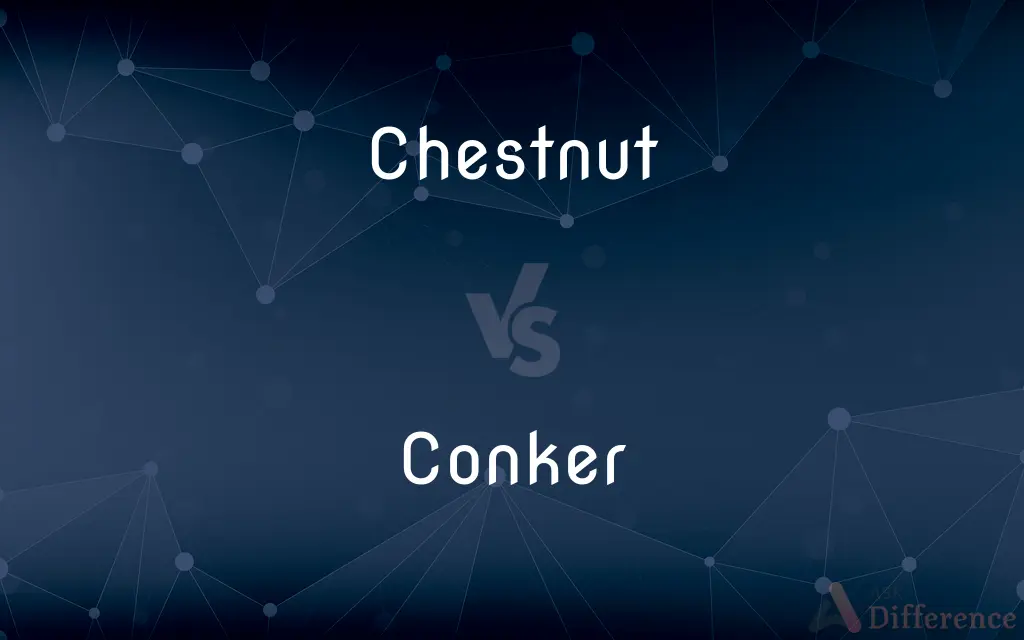Chestnut vs. Conker — What's the Difference?
Edited by Tayyaba Rehman — By Fiza Rafique — Updated on March 7, 2024
Chestnuts are edible nuts from Castanea species, while conkers are inedible seeds of the horse chestnut tree, Aesculus hippocastanum.

Difference Between Chestnut and Conker
Table of Contents
ADVERTISEMENT
Key Differences
Chestnuts come from various species of the genus Castanea and are known for their sweet, nutty flavor, making them popular in culinary uses around the world. They can be roasted, boiled, or incorporated into dishes, providing both flavor and nutritional benefits. On the other hand, conkers, the seeds of the horse chestnut tree, are not edible due to their bitter taste and potentially toxic substances. They are primarily known for their use in the traditional children's game "conkers" in some parts of the world.
While chestnuts are cultivated for their nuts, valued in both cuisine and some traditional medicines, conker trees are often grown for ornamental purposes, admired for their large, showy flowers in spring. The horse chestnut tree's broad, palmate leaves and stature add aesthetic value to landscapes, whereas chestnut trees are appreciated not only for their ornamental beauty but also for their fruit-bearing capabilities.
The outer shell of a chestnut is spiny or bur-like, designed to protect the nut inside until it is ripe for harvesting. In contrast, conkers are encased in a green, spiky husk that splits open to reveal the glossy brown seed when they are mature. The appearance of the seed itself is a key distinguishing feature; chestnuts have a pointed tip and a flat bottom with a characteristic tuft or 'tail', while conkers are more uniformly round or slightly flattened without a pointed end.
In terms of cultural significance, chestnuts play an important role in various traditions and cuisines, particularly in Asia and Europe. They are associated with autumn and winter festivities, often roasted and sold as street food during the colder months. Conkers, meanwhile, hold a special place in British and Irish culture due to the game associated with them, where two players each use a conker strung on a piece of string to try and break their opponent's conker.
Comparison Chart
Origin
Genus Castanea
Aesculus hippocastanum
ADVERTISEMENT
Edibility
Edible and used in various cuisines
Inedible and toxic
Primary Use
Culinary and medicinal
Ornamental and recreational (game)
Shell Appearance
Spiny or bur-like
Green, spiky husk
Seed Appearance
Pointed tip with a flat bottom
More uniformly round or slightly flattened
Cultural Significance
Associated with autumn and winter festivities
Associated with the children's game in the UK and Ireland
Compare with Definitions
Chestnut
Edible nut of the Castanea species.
Roasted chestnuts are a popular snack in winter.
Conker
Inedible seed of the horse chestnut tree.
Children collect conkers for playing rather than eating.
Chestnut
Encased in a spiny shell.
Gathering chestnuts requires gloves to handle the spiny outer shell.
Conker
Used in the traditional game "conkers".
The annual World Conker Championships attract participants of all ages.
Chestnut
Associated with autumn and winter.
Chestnut roasting is a common sight during the holiday season.
Conker
Encased in a green, spiky husk.
The ground is littered with conker husks in autumn.
Chestnut
Cultivated for culinary and medicinal purposes.
Chestnut extracts are used in some traditional medicines.
Conker
Grown for ornamental purposes.
The horse chestnut tree is valued for its aesthetic appeal in parks.
Chestnut
Known for its sweet, nutty flavor.
Chestnut puree is used in various desserts.
Conker
Part of British and Irish children's culture.
Playing conkers is a cherished autumn tradition in schools.
Chestnut
The chestnuts are a group of eight or nine species of deciduous trees and shrubs in the genus Castanea, in the beech family Fagaceae. They are native to temperate regions of the Northern Hemisphere.
Conker
A horse chestnut.
Chestnut
A glossy hard brown edible nut which develops within a bristly case and which may be roasted and eaten.
Conker
Con·kers A game in which two players swing horse chestnuts strung on string, with both players trying to use their own horse chestnut to shatter their opponent's.
Chestnut
The large European tree that produces the edible chestnut, with serrated leaves and heavy timber.
Conker
One that conks or hits.
Chestnut
A small horny patch on the inside of each of a horse's legs.
Conker
One that conks, as when styling hair.
Chestnut
Any of several deciduous trees of the genus Castanea native to northern temperate regions, having alternate simple toothed leaves, and nuts that are enclosed in a prickly husk.
Conker
(British) A horse chestnut, used in the game of conkers.
Chestnut
The often edible nut of any of these trees.
Conker
The inedible nutlike seed of the horsechestnut.
Chestnut
The wood of any of these trees.
Conker
The inedible nutlike seed of the horse chestnut
Chestnut
Any of several other plants, such as the horse chestnut.
Chestnut
A moderate to deep reddish brown.
Chestnut
A reddish-brown horse.
Chestnut
A small hard callus on the inner surface of a horse's foreleg.
Chestnut
An old, frequently repeated joke, story, or song.
Chestnut
Of a moderate to deep reddish brown.
Chestnut
A tree or shrub of the genus Castanea.
Chestnut
A nut of this tree or shrub.
Chestnut
(uncountable) A dark, reddish-brown colour, as seen on the fruit of the chestnut tree.
Chestnut
A reddish-brown horse.
Chestnut
(uncountable) The wood of a chestnut tree.
Chestnut
(figurative) An old joke; a worn-out meme, phrase, ploy, etc. so often repeated as to have grown tiresome or ineffective (often in the phrase "old chestnut").
Chestnut
A round or oval horny plate found on the inner side of the leg of a horse or other animal, similar to a birthmark on a human.
Night eye
Chestnut
(UK) The horse-chestnut.
Chestnut
Of a deep reddish-brown colour, like that of a chestnut.
Chestnut
The edible nut of a forest tree (Castanea vesce) of Europe and America. Commonly two or more of the nuts grow in a prickly bur.
Chestnut
The tree itself, or its light, coarse-grained timber, used for ornamental work, furniture, etc.
Chestnut
A bright brown color, like that of the nut.
Chestnut
The horse chestnut (often so used in England).
Chestnut
One of the round, or oval, horny plates on the inner sides of the legs of the horse, and allied animals.
Chestnut
An old joke or story.
Chestnut
Of or pertaining of a chestnut; of a reddish brown color; as, chestnut curls.
Chestnut
Wood of any of various chestnut trees of the genus Castanea
Chestnut
Any of several attractive deciduous trees yellow-brown in autumn; yield a hard wood and edible nuts in a prickly bur
Chestnut
Edible nut of any of various chestnut trees of the genus Castanea
Chestnut
A small horny callus on the inner surface of a horse's leg
Chestnut
A dark golden-brown or reddish-brown horse
Chestnut
Used of hair; of a golden brown to reddish brown color;
A chestnut horse
Chestnut hair
Common Curiosities
What is the traditional game involving conkers?
The traditional game involves players using a conker tied to a string to break their opponent's conker.
What is a chestnut?
A chestnut is an edible nut from the genus Castanea, known for its sweet, nutty flavor.
How can you tell a chestnut from a conker?
Chestnuts have a spiny shell and a pointed tip with a flat bottom, while conkers have a green, spiky husk and are more uniformly round.
Is there a championship for the game of conkers?
Yes, there are conker championships, such as the World Conker Championships, held annually in the UK.
What dishes can be made with chestnuts?
Chestnuts can be used in a variety of dishes, including soups, stuffings, desserts, and as a puree for sweet and savory recipes.
Can chestnuts be used in cooking?
Yes, chestnuts are versatile in cooking and can be roasted, boiled, or used in various dishes.
Are conkers edible?
No, conkers, the seeds of the horse chestnut tree, are inedible and considered toxic.
Are chestnuts good for your health?
Yes, chestnuts are nutritious, offering vitamins, minerals, and fiber, making them a healthy food choice.
Where do conker trees commonly grow?
Conker trees, or horse chestnut trees, are commonly found in temperate regions and are often planted in parks and gardens for their ornamental value.
How do conkers contribute to children's play?
Conkers have been a popular element in children's play in some cultures, particularly in the UK and Ireland, where the game of conkers is a traditional autumn activity.
What is the significance of chestnuts in autumn and winter?
Chestnuts are associated with autumn and winter festivities, often enjoyed roasted as a traditional snack during the colder months.
Can you grow a tree from a conker?
Yes, a horse chestnut tree can be grown from a conker, although it requires proper conditions and care to germinate and grow.
What is the cultural importance of chestnuts in certain regions?
In many cultures, especially in Asia and Europe, chestnuts hold significant cultural importance, featuring in traditional recipes and festivities.
Are there different varieties of chestnuts?
Yes, there are several species of chestnuts, including European, American, and Asian varieties, each with unique characteristics.
How are chestnuts harvested?
Chestnuts are harvested in autumn when the spiny shells fall to the ground and split open, revealing the nuts inside.
Share Your Discovery

Previous Comparison
Drawal vs. Drawl
Next Comparison
Conclusion vs. PremiseAuthor Spotlight
Written by
Fiza RafiqueFiza Rafique is a skilled content writer at AskDifference.com, where she meticulously refines and enhances written pieces. Drawing from her vast editorial expertise, Fiza ensures clarity, accuracy, and precision in every article. Passionate about language, she continually seeks to elevate the quality of content for readers worldwide.
Edited by
Tayyaba RehmanTayyaba Rehman is a distinguished writer, currently serving as a primary contributor to askdifference.com. As a researcher in semantics and etymology, Tayyaba's passion for the complexity of languages and their distinctions has found a perfect home on the platform. Tayyaba delves into the intricacies of language, distinguishing between commonly confused words and phrases, thereby providing clarity for readers worldwide.















































